For delicious steak, chicken and more, having the best meat thermometer at your disposal is an absolute must.
Our editors and experts handpick every product we feature. We may earn a commission from your purchases.Learn more.
For delicious steak, chicken and more, having the best meat thermometer at your disposal is an absolute must.
Our editors and experts handpick every product we feature. We may earn a commission from your purchases.Learn more.
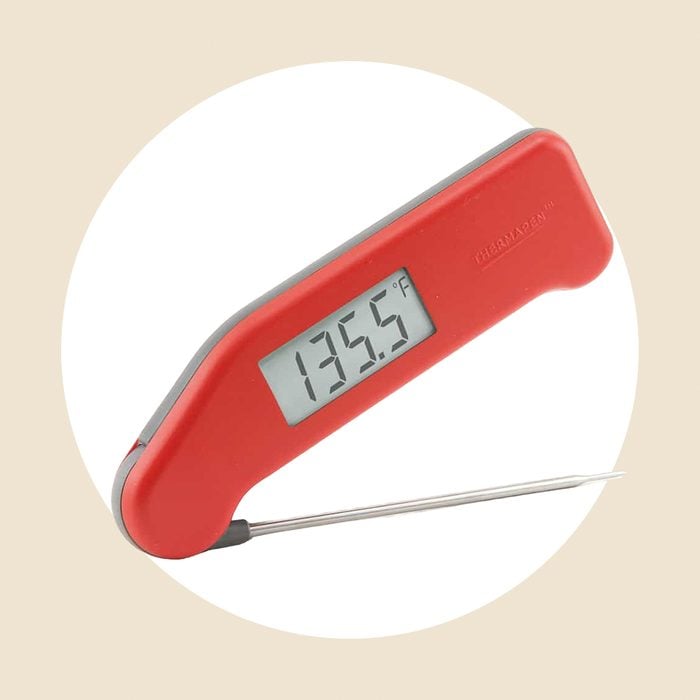 via merchant
via merchant
Countless chefs, brewers, professional pit masters and other food professionals believe the ThermoWorks Classic Thermapen is the best meat thermometer—and we agree. It gives precise temperature readings in less than three seconds, with a high accuracy of ±0.7 degrees. It even comes with a National Institute of Standards and Technology (NIST)-Traceable calibration certificate, so you know it’s accurate. For cooking projects where precision is paramount, you can adjust the screen options to measure temperatures to the decimal point instead of rounding it to the nearest degree.
The Thermapen uses Biomaster silver ion technology to prevent microbial growth. Plus, you’ll never worry about it going dead when you need it most—the battery lasts a whopping 1,500 hours, so this gift for grillers will be charged for years (maybe decades!) to come. Our Test Kitchen is also a fan of the Thermapen One.
Pros
Cons
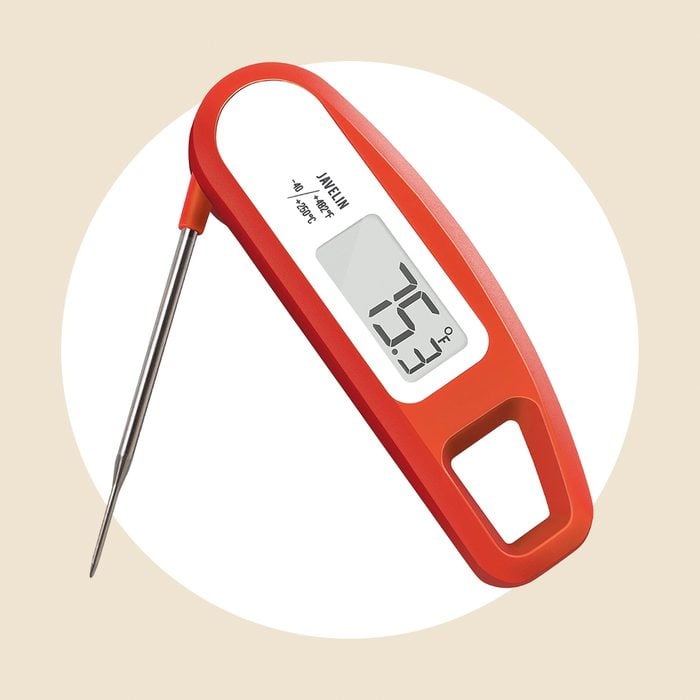 via merchant
via merchant
This best meat thermometer is a relative bargain, with more than 15,600 five-star Amazon ratings singing its praises. It takes only three to four seconds for this digital thermometer to deliver temperature readings with ±0.9 degree accuracy, and it’s not bad to look at, either. Available in nine vivid colors, you’ll be able to show it off—and keep it handy—with an integrated magnet that sticks to refrigerators, ovens and other metal surfaces.
Built to last, this instant-read thermometer is made with high-quality, impact-resistant materials that resist warping or cracking, like 100% bisphenol A (BPA)-free polycarbonate and food-grade stainless steel. This National Science Foundation (NSF)-approved pick complies with international food-safety guidelines, making it ideal for both home and professional use.
Pros
Cons
 via merchant
via merchant
The wireless Meater+ smart thermometer keeps an eye on both ambient oven and internal meat temps with utter precision, relaying the info to a free smartphone app in real-time. The attractive bamboo charging base doubles as a Bluetooth booster, letting you keep a constant eye on your meat from up to 165 feet away. Connect it to your Echo or Alexa and you can receive updates from almost anywhere! A full charge lasts up to 24 hours, making the Meater+ ideal for smoking, slow roasting or braising meat.
A wide variety of presets makes it easy to cook almost any meat to its ideal cooking temperature. The Meater app also includes an Advanced Estimator Algorithm, which helps plan meals and manage your time in the kitchen. This smart kitchen gadget boasts over 26,000 five-star Amazon ratings, including Hector Baez who says, “Gone are the days of multiple probes trying to see the temp inside my smoker. This thing accomplished everything I needed it to. Being able to sync multiple devices with the app was a game changer. I can see my temp from wherever I was in the house. I’m only upset I waited so long to buy this. It’s a must-have.”
Pros
Cons
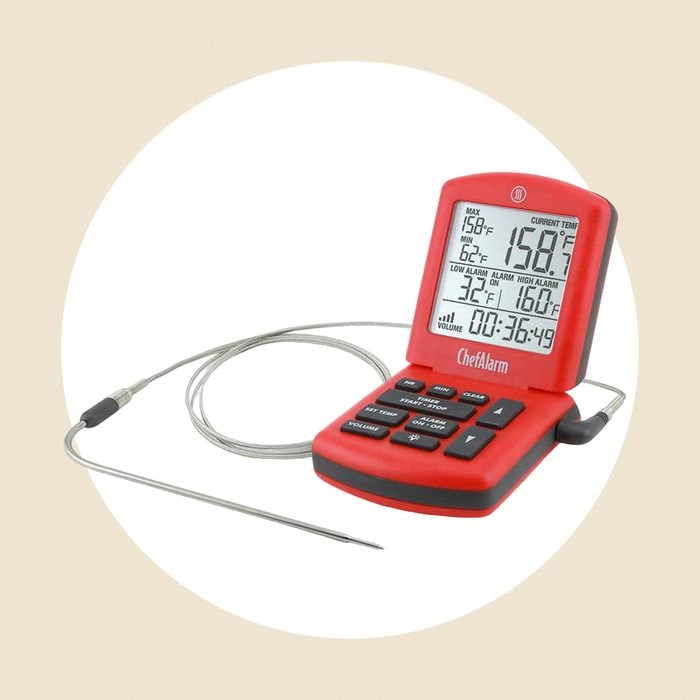 via merchant
via merchant
The ChefAlarm is designed for professionals, but is still a top-notch choice for any aspiring pit master who loves spending their weekend slow-smoking meats in the backyard. It uses ThermoWorks’ commercial-grade Pro-Series Temperature Probes, which are renowned for their exceptional accuracy, reading speed and durability (it can measure up to 572 degrees Fahrenheit!).
An easy-to-read display shows all the data in large, backlit text so you can see it from across the kitchen. If you need to walk away, an alarm will keep you on top of things. This best meat thermometer’s display can be tilted up and set on a counter. Or, fold it flat and use the magnetic back to attach it to your oven, grill or magnetic knife strip. It’s available in nine colors, so you won’t mind showing it off.
Pros
Cons
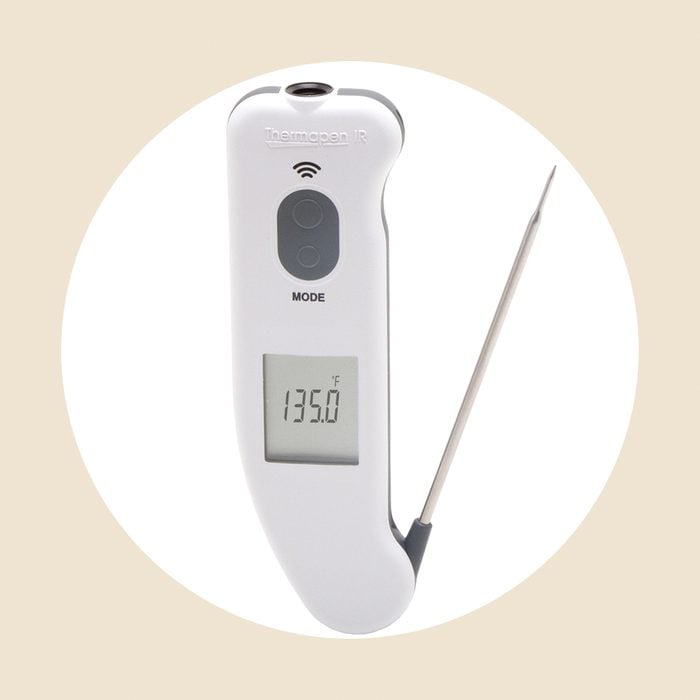 via merchant
via merchant
Probe thermometers provide accurate readings when making candy, bread and (of course) meat, but there are some things in the kitchen they can’t measure. You’ll need an infrared surface temperature gun for measuring the surface of a cast iron skillet, preheated grill grates or a slick of hot oil on the bottom of a pan. The Thermapen IR combines the two into one outstanding grilling tool, making it the best meat thermometer if you’re a serious cook who’s willing to splurge.
The temperature probe has a thin tip that gives quick readings with superb accuracy, measuring temps within ±0.7 degrees in less than three seconds. The probe folds like a pocket knife, turning on when it’s extended, and off when folded away. To preserve battery life, it automatically turns off if left untouched for 30 seconds. To use the Thermapen IR’s infrared feature, simply aim the sensor toward the surface you want to read, then press the scan button.
“This was a gift for my husband and he loves it,” writes verified customer, Renee S., in her five-star review. “He uses it with the gas barbecue, with the Ooni pizza oven and with the Weber smoker. I use it for quick temperature checks when baking and cooking, as well, so an excellent purchase!”
Pros
Cons
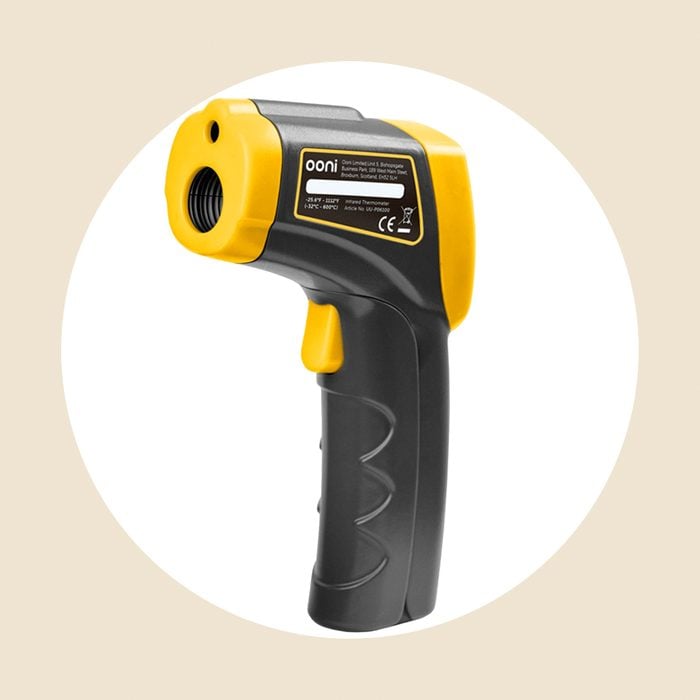 via merchant
via merchant
The Ooni Infrared isn’t technically a meat thermometer, but since we love a good pepperoni pizza, we’re including on this list anyway. Aim the laser pointer at the floor of your pizza oven, and an accurate temperature reading will pop up on the backlit display screen. The ideal temperature for a pizza stone is 752 degrees Fahrenheit, which is hot enough to cook small pieces of sausage on top of your pie.
“We just baked two pizzas last night using our new Ooni infrared thermometer,” writes verified buyer, Bonnie S. “It made an incredible difference in the quality—our pizzas were outstanding. Before we used the thermometer, our Ooni stone was not hot enough and the crust was too soft. Last night it was PERFECT. So happy we bought this new gadget.”
Pros
Cons
Here are some factors to keep in mind while figuring out which model is the best meat thermometer for you:
As shopping experts, our only job is to help you find a winning product. We start with the research and reporting basics—what products are made of, what they look like and how much they cost—to ensure that we’re only recommending the buys that are worth your time and money. Then, we research the features that speak to the product’s quality, taking advice from industry insiders and subject matter experts on what makes a product a smart value (or worthy of a splurge). Finally, we do the work of combing through user reviews to see how real people interact with the product, and if it stands up to the test.
First, insert the thermometer probe into the thickest part of the meat—be careful to avoid fat, gristle or bones. If you’re cooking poultry, insert the thermometer into the thickest part of the thigh or breast, which takes the longest to cook. Once inserted, wait a few seconds for the temperature reading, then remove and clean the probe immediately. Using a clean probe every time ensures a more accurate reading.
Analog thermometers have a gauge on top of a long metal probe; as the probe sits in the meat, the dial will slowly move to the correct temperature. A digital thermometer shows the temperature on a display in a matter of seconds, making it easier to read than analog models.
Some meat thermometers are specifically designed to be left inside of meat while cooking, like the Meater+ and ChefAlarm Oven Probe. Instant-read thermometers, like the ThermaPen and Javelin, cannot be left in meat while cooking, and should only be inserted briefly to monitor temperatures.